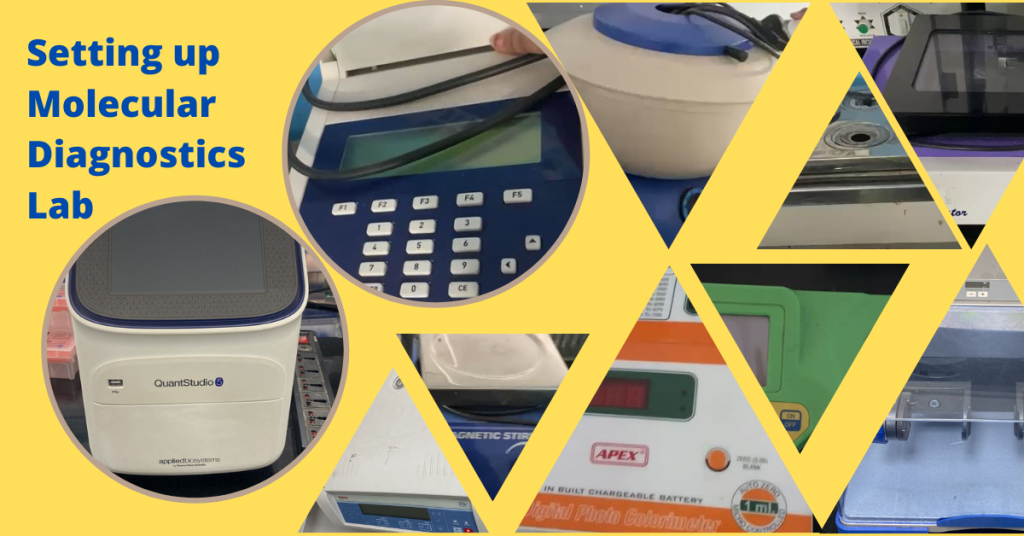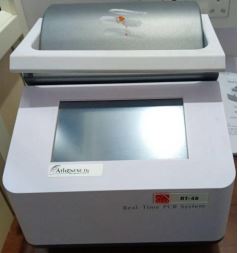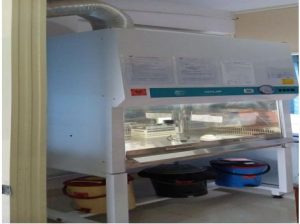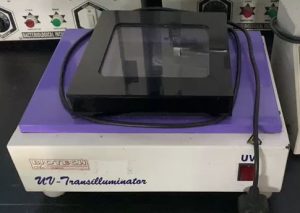
India’s bio-economy is growing at a rapid pace and medical biotechnology or molecular diagbostics has come into main stream, especially since Covid-19. Molecular diagnostics is now commonly performed along with conventional histopathological and serology methods. While requirements may vary somewhat depending on the spectrum of the tests that will be performed, there are several basic needs to be fulfilled for standardization. Adequate space, appropriate equipment, qualified personnel and stringent SOPs especially with a view to preventing contamination are required to set-up molecular diagnostics lab of good standards. https://www.ncbi.nlm.nih.gov/pmc/articles/PMC10510618/
The Indian Molecular Diagnostics equipment market can be primarily segmented based on application and technology. Based on application, the market is segmented into infectious disease, blood screening, genetic testing and oncology testing, out of which oncology testing segment is the dominant segment in the short-to-medium term, followed by the infectious disease segment. In terms of technology the market is divided into PCR, In-situ Hybridization, Chips and Microarrays and Others. During Covid-19 years the application in infectious disease segment and RT-PCR or the Polymerase Chain Reaction (PCR) based methods became highly popular.
Equipment for a basic biotechnology lab
If you are setting up or expanding an existing lab to include RT-PCR assays, at a minimum, your lab will need these small laboratory equipment items to prepare and perform tests for various infectious diseases like COVID-19 PCR tests. A basic biotechnology lab setup typically needs the following equipment:
- RT-PCR (Polymerase Chain Reaction) machine or Thermocycler and Gel Electrophoresis
- Deep Freezer (-80 degrees)
- Freezer (-20 degrees)
- BioSafety Cabinet
- Laminar Airflow
- Refrigerated Centrifuge
- Vortex Mixer
- Binocular Microscope
- Incubator
- Autoclave/ sterilizer
- Micro-centrifuge
- Refrigerator
However, to establish a successful medical biotechnology lab, adequate space with proper layout, appropriate equipment and qualified personnel are a must. This is because PCR testing is vulnerable to cross contamination, especially from external DNA sources like hair and body fluids from technicians’ itself.
Contamination can lead to erroneous results and irreparable damage to lab’s reputation. Also, the clean-up/sterilization process and efforts to identify the source of contamination can lead to lab downtime and delays, which have negative financial and performance impacts. Good laboratory design, rigorous training staff and stringent deployment of SOP (Standard Operating Procedures) is the most effective way to ensure contamination is rare. Hence, special considerations, such as providing adequate space, appropriate equipment, and qualified personnel, must be made.
This blog will address only the information related to required medical equipment for a RT-PCR or biotechnology lab and only provide pointers for other information related to lab design etc.
PCR based testing process

The complete test is done in four steps as follows:
- Pre-PCR procedures
- Sample preparation – microdissection and/or DNA/RNA extraction
- PCR / Reagent preparation
- Post-PCR procedures
- Polymerase Chain reaction (PCR)
- Post-PCR analysis
Ideally, a molecular testing laboratory should have three or four separate rooms for each step of the process. At the very least two rooms are recommended — clean room for sample and reagent preparation, dirty room for PCR amplification and analysis always ensuring unidirectional flow from clean to dirty and never back.
Molecular lab equipment and devices
Every area or room in a molecular testing laboratory should be equipped adequately and appropriately to the work done. To avoid any contamination, dedicated equipment should be provided and sharing equipment must be avoided. Standard appliances and equipment to set-up molecular diagnostics lab include the following:
Reagent preparation process
Objective – This reagent preparation room must be the cleanest areas in a molecular testing laboratory. This area is dedicated to the preparation and aliquoting of reagent stock and preparing reaction mixes. If there is any biomaterial such as DNA/RNA, this may contaminate the reagents and this will only get amplified in the next step. Hence, positive air-pressure must be maintained in the room so that no external material comes even through the air. If a separate room is not possible, then the reagent preparation is recommended to be done in laminar hood.
Equipment used in reagent preparation
- Equipment required in PCR reagent preparation room includes pipettes/ micropipettes and tips, vortex mixers, spin-down centrifuges, a refrigerator,-200 freezer (~100L capacity) and laminar hoods.
| Equipment | Purpose / Use |
| Refrigerator | For storage of chemicals and PCR products at an average temperature of +40C. |
| Vortex mixer | For mixing small vials quickly in an oscillating circular motion and for the resuspension of cells. Vortex mixers are available with variable speeds and the option for continuous function or on-demand function. |
| Centrifuge | To separate fluids, gases, or liquids based on density. There are various types of centrifuge, which are classified by either the intended use or the rotor design. |
| Autoclave | To sterilize waste and lab equipment. |
| Laminar flow | To prevent contamination. |
| Hot-air oven | To heat up the products at a uniform temperature or to sterilize the product in a particular period of time under specific conditions like humidity, pressure, and other environmental factors. |
Sample receipt & preparation
Objective – Sample preparation process includes nucleic acid extraction and addition to PCR reaction mixes. Preferably both these processes should be done in two different rooms. If there is insufficient space for two rooms, the two steps can be done in the same room but in different areas or compartments. Proper sample preparation area is crucial to set-up molecular diagnostics lab.
A vortex mixer is used to remove the cell material from the sample received. This process can take around 30 minutes. Nucleic acid extraction and addition to reaction mix should be ideally done in biosafety cabinets to protect the technician, the sample and the environment from potentially getting infected. Stringent waste management system should be in place or else all good work in the lab can go to waste due to contamination from improperly discarded/ handled waste.
- Equipment required for the sample preparation includes high-speed centrifuges, vortex mixers, pipettes, autoclaves, refrigerated and non-refrigerated centrifuges or separation of components based on density, refrigerators, -20°C and -80 °C deep freezer for storage of tissue culture and frozen samples, bio-safety cabinets and laminar flow hoods.
| Equipment | Purpose / Use |
| Refrigerator | For storage of chemical kits and PCR products at an average temperature of +40C. |
| Freezer | For storage of frozen tissue cultures and samples at temperatures ranging between -200C and -800C. |
| Vortex mixer | For mixing small vials quickly in an oscillating circular motion and for the resuspension of cells. Vortex mixers are available with variable speeds and the option for continuous function or on-demand function. |
| Refrigerated / Non-refrigerated Centrifuge | To separate fluids, gases, or liquids based on density. There are various types of centrifuge, which are classified by either the intended use or the rotor design. |
| Microscope | For the observation and evaluation of samples. |
| Autoclave | To sterilize waste and lab equipment. |
| Laminar flow & biosafety cabinets | To prevent contamination. |
| Incubator | To maintain optimal conditions, such as temperature and humidity. |
| pH meter | For measuring hydrogen-ion activity in water-based solutions. |
| Dry heat block and/or water bath | For incubating samples at a constant temperature. |
Other equipment in sample preparation
Other equipment and appliances that could be additionally used in sample preparation if samples are varied and volumes are high are listed below:
| Equipment | Purpose of Use |
| Nucleic Acid Extractor | For DNA/ RNA extraction if volumes are high |
| Microwave | Heating, drying, vaporizing |
| Microtome | Sectioning |
| Slide oven | Slide drying, sterilization, maintaining constant/certain temperature levels |
| Magnetic Stirrer | For stirring or mixing a solution |
| Tissue processor | Tissue processing |
| Tissue embedding machine | Tissue embedding |
| Slide stainer | Staining |
| Coverslipper | To cover slides |
| Immunohistochemistry staining system | Immunohistochemical staining |
| Automated pipetting system | Handling of precise volumes of samples & reagents |
| Water de-ionizing / purification system | For ensuring un-contaminated water |
Amplification and post-amplification analysis
Objective – The main objective of the PCR process is to amplify the DNA quantity from available sample, which is insufficient to conduct a test. The post-PCR process may involve DNA detection, quantification and sequencing depending on investigation required. These two comprise the contaminated (dirty) rooms. Therefore, no equipment or material used in these rooms can be transferred to or used in other rooms. A laminar flow hood is recommended for any steps requiring the opening of tubes containing amplicons. To control contamination further, it is also critical that laboratory technicians performing post-PCR analysis do not return to pre-PCR work areas on the same day.
Equipment used in PCR process
- Equipment required in PCR process includes the RT-PCR machine or Thermocycler, pipettes, spin-down centrifuges and laminar hoods.
| Equipment | Purpose / Use |
| Thermal cycler | A PCR machine—or a thermocycler—is an instrument that amplifies target nucleic acid sequences into millions of copies via polymerase chain reaction. It is called a thermocycler because it cycles at different temperatures – 90-950 for denaturing, 37-650 for primer annealing and 720 for polymerase extension. In conventional PCR or thermocycler, the amplified DNA product, or amplicon, is detected in an end-point analysis, normally using another equipment like Gel Imaging or Gel Electrophoresis etc. |
| RT-PCR machine | In real-time PCR, the accumulation of amplification product is measured as the reaction progresses, in real time, with product quantification after each cycle. It is also used for DNA sequencing, cloning, generation of probes, quantification of DNA and RNA, studying patterns of gene expression, detection of sequence-tagged sites, and many more techniques. |
| Spectrophotometer | The quality and yield of DNA are assessed by spectrophotometry or by gel electrophoresis. UV spectrophotometry is the standard method for quantification of DNA/RNA. The absorption at 260 nm correlates with the concentration of nucleotides. Absorption at 280 nm gives a measure of residual protein. The A260/A280 ratio is a measure of purification; it should fall in the range 1.8–2.0 |
| Electrophoresis system | For conducting PCR analysis. |
| DNA sequencer | For the observation of DNA’s molecular sequence. |
| Gel imaging system | For analysis of proteins, nucleic acid, and antibodies. |
| Immunoassay systems | To study assays |
| ELISA readers | ELISA (enzyme-linked immunosorbent assay) is a method used to quantitatively detect an antigen within a sample. |
| Centrifuge | To separate fluids, gases, or liquids based on density. There are various types of centrifuge, which are classified by either the intended use or the rotor design. |
| Autoclave | To sterilize waste and lab equipment. |
| Laminar flow and biosafety cabinets | To prevent contamination. |
| Microscope | For the observation and evaluation of samples. |
| Refrigerator and -200 freezer | For maintaining required temperature |
| Hybridizer | In situ hybridization |
| Ultraviolet light illuminator | To prevent contamination via ultraviolet light illumination |
Equipment used in Post-PCR analysis process
- If Thermocycler has been used for PCR, equipment required in Post-PCR analysis process includes the Gel Electrophoresis machine, Spectrophotometer and/ or DNA sequencer, as required. RT-PCR machine however handles both amplification and analysis in real-time at the end of each cycle.
| Equipment | Purpose / Use |
| RT-PCR machine | In real-time PCR, the accumulation of amplification product is measured as the reaction progresses, in real time, with product quantification after each cycle. It is also used for DNA sequencing, cloning, generation of probes, quantification of DNA and RNA, studying patterns of gene expression, detection of sequence-tagged sites, and many more techniques. RT-PCR is much safer as it is a closed-loop system with minimal chance of contamination. |
| Electrophoresis system | For conducting PCR analysis. |
| DNA sequencer | For the observation of DNA’s molecular sequence. |
| Gel imaging system | For analysis of proteins, nucleic acid, and antibodies. |
| Immunoassay systems | To study assays |
| ELISA readers | ELISA (enzyme-linked immunosorbent assay) is a method used to quantitatively detect an antigen within a sample. |
| Autoclave | To sterilize waste and lab equipment. |
| Laminar flow and biosafety cabinets | To prevent contamination. |
| Microscope equipped with camera system | Evaluation and archiving of test results |
| Ultraviolet light illuminator | To prevent contamination via ultraviolet light illumination |
Conclusion – To set-up molecular diagnostics lab
Equipment and appliances may slightly differ between molecular pathology laboratories based on their testing profile. To set-up molecular diagnostics lab, most other equipment and consumables used in the routine pathology setting must also be available in a molecular pathology laboratory, as well, like Lab coat, ethanol, gloves, test tubes, safety glasses, waste bins etc.
Just providing adequate space is not good enough. To set-up molecular diagnostics lab, proper lab design including; mechanical barriers to prevent contamination, spatial separation of pre- and post-amplification work areas, adequate equipment and devices in each area, unidirectional workflow, proper ventilation and air pressure in each area is necessary to prevent contamination.
Check out the following link for an excellent lab layout and other information related to set-up molecular diagnostics lab.
A complete guide to set-up molecular diagnostics lab can be found here too.
Most popular Molecular Diagnostics equipment brands in India are from Thermo Fisher Scientific (Applied Biosystems), Bio-Rad, Roche Diagnostics, Abbott India, Qiagen, AltaSciences, bioMerieux, Becton Dickinson, Biocartis, Bio-Techne, Danaher, Cleaver Scientific, etc.
Even if going for minimum specifications and cheapest equipment models, for the above one should budget for at least Rs 10-20 lakhs of investment. If however you are considering refurbished/ used equipment, costs could be half or 65% of the above. Buy or sell used biotechnology equipment here at Primedeq India.
For more understanding of setting up a Covid-19 lab check out the following video
—————————————————————————————————————————
PrimedeQ is an e-Marketplace for buying, selling, renting, servicing and spares of medical equipment. We offer all types of used / refurbished medical equipment , including used biotechnology laboratory equipment, molecular diagnostics lab, dental chair, ultrasound, ECG machine and other diagnostic equipment, endoscopes, OT equipment, Laparoscopic Equipment, Lab equipment, X-Ray, TMT, anesthesia machine, ultrasound machines etc. We offer repair services for all types of medical equipment including Lab equipment, microdebrider, laparoscope , rigid and flexible endoscopes as well as EUS (Endoscopic Ultrasound Units) and ultrasound probe etc. Primedeq can also assist in proper dismantling and disposal of used medical equipment.
Contact us for any medical equipment requirements @ 7019759765/ 8971223957 or [email protected]
https://in.linkedin.com/in/shanthi-mathur-ab07838





